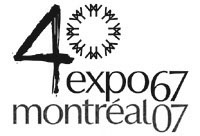|
July 1
CANADA DAY CEREMONY AT EXPO 67
"As we enter our centennial year we are still a
young nation, very much in the formative stages. Our national condition is still
flexible enough that we can make almost anything we wish of our nation. No other
country is in a better position than Canada to go ahead with the evolution of a
national purpose devoted to all that is good and noble and excellent in the
human spirit." - Prime Minister Lester Pearson, 1967.
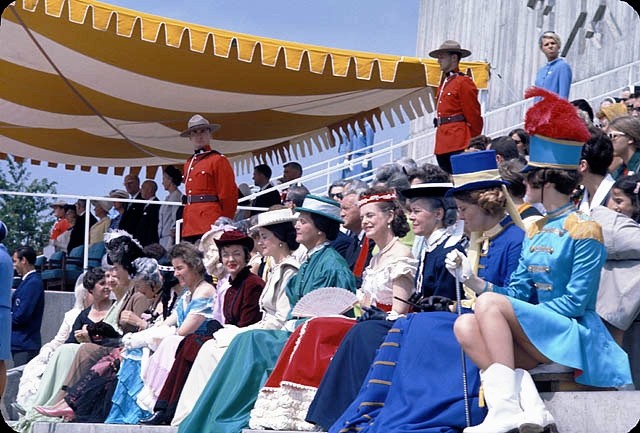
Photo credit © National Archives of Canada
Above photo: July 1, 1967, Canada Day at Expo 67
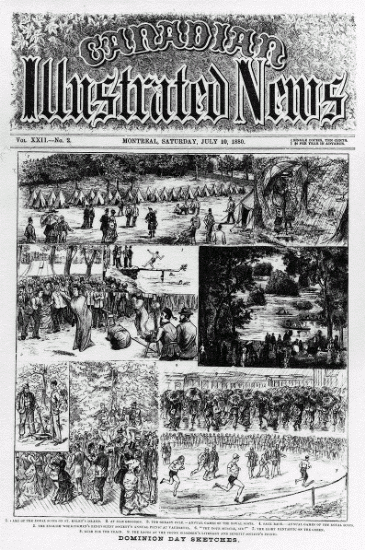 |
|
Photo credit © National
Archives of Canada
Dominion Day Sketches. Artist: Unknown
Date: 10 July
1880
Pagination: vol.XXII, no. 2, 17
Notes: 1. Camp of the Royal Scots
on St. Helen's Island -- 2. At Isle Grosbois -- 3. The Greasy Pole: Annual Games
of the Royal Scots --
4. Sack Race -- 5. The English Workingmen's Annual
Picnic -- 6. Try Your Muscles, Sir... -- 7. The Light Fantastic on the Green --
8. Rush for the Train -- 9. The Races at the Young Irishmens' Literary and
Benefit Society's Picnic
|
Canada Day
Background
Sir Charles Stanley Monck (Lord Monck, who became
the first Governor-General of Canada from 1867-68), signs a proclamation on June
20, 1868, requesting Her Majesty's subjects to celebrate the anniversary of the
formation of the union of the British North American provinces under the name of
Canada on July 1st.
May 15, 1879: Royal Assent was given to make July 1
a public holiday which would be named "Dominion Day."
After this first anniversary, there are no records
to indicate that ceremonies for the holiday were organized, not until the 50th
anniversary of Confederation which fell on 1917. It took a proclamation
from the Duke of Devonshire as the Governor General, on June 16, 1917, to set
in motion the celebrations of the 50th anniversary of Confederation. A new Centre Block of the Parliament Buildings (under
construction) was dedicated as a memorial to the Canadian military who fought
with valor during the 1st World War. The Centre Block was
also dedicated to the Fathers of Confederation.
February 18, 1927: Royal Assent was given for the
"Diamond Jubilee of Confederation Act & 1927 Incorporation of National
Committee." From that, a grant of $250,000 and a 48-page colour pamphlet suggesting ways on
how to celebrate a national thanksgiving, i.e. historical pageants, floats and
tableaux were administered and distributed across the Dominion of Canada.
Ottawa celebrated on July 1, starting at
11:00 AM. The festivities included:
A) The laying of the cornerstone by the
Governor General of the Confederation Building on Wellington Street and the
inauguration of the Carillon in the Peace Tower.
B) In the afternoon, citizens heard speeches
from Prime Minister William Lyon Mackenzie King; Governor General Willingdon;
the official Opposition leader; and descendants of the fathers of
confederations. The mix to this afternoon pomp and ceremony included public
singing, a centenary choir and school children.
C) A dinner was held at the Parliament
buildings, organized by the National Committee and followed up that night with a
historical parade.
1958: Dominion Day format includes "Trooping the Colours" during an afternoon ceremony
on the front lawn of Parliament Hill. Evening festivities would include mass
band concerts and fireworks display.
July 1st, 1967: On this date (which happened to
fall on a Saturday), Queen Elizabeth II
pays tribute to Canada's Centennial in Ottawa (see excerpts
below from that
speech). The Queen would visit Expo 67 on Monday, July 3rd.
|
"It is a hundred years of nationhood that we
celebrate today. But let us not forget the earlier centuries of arduous labor
that came before Confederation. I am not likely to overlook the contributions
made by those British stock who came here from elsewhere in North America or who
were settlers from the old world in the new. Even more extended in time, and as
deep in impact, have been the contributions made by Canadians of French descent.
Ever since Champlain founded his Habitation at Québec -- and planted those rose
bushes around it -- this air has been sweetened with the French tongue and
French culture and sharpened with French intelligence and French resource. It is
one of the marvels of history that a society planted so precariously in the
wilderness should not only have survived but should have flourished so
triumphantly, still loyal to its past and open to everything that is new. From
all I hear, from everything I know, I am sure that the contributions of French
Canada to the life of this country as a whole will prove even ampler in the
future than they have been in the years gone by.
"Confederation has given Canada the economic
strength which has made it possible for her to help the needy countries in their
economic development; it has made it possible for Canada to provide forces to
help keep the peace where it has been threatened, and, above all, it has given
increasing power and authority to Canada's voice in world affairs. This power
and authority derives from the internal national unity and it can only be
sustained and flourish if that national unity prospers.
"From the very earliest days, the name of Canada is associated with prodigious
voyages of the seamen from Bristol and St. Malo in their tiny ships, then the
explorers who went by canoe up the Ottawa to the Great Lakes and along the
waterways of the Middle West to the Rockies and beyond. With the beginning of
this new century the whole Canadian nation embarks on another great voyage. May
it bring peace and prosperity, happiness and harmony and a just reward for the
work and endeavor of each one of you." - Queen Elizabeth II
|
1968: Under the banner, "Festival Canada",
this new
format showcases multicultural and professional concerts held on the front lawn
of Parliament Hill that would include a nationally televised show. For the month
of July, the National Capital Region throws the spotlight on cultural, artistic
and sport activities. Involvement included the various municipalities and
voluntary organizations. "Festival Canada" was cancelled in 1976 but reactivated
in 1977.
1980: Yet another new format by the National
Committee, this one stressing more local celebrations across Canada with cash
being injected to promote popular and amateur activities organized by volunteer
groups. This approach was adopted again in 1981 but this time 15 major cities
across Canada would include a "fireworks" display.
October 27, 1982: "Dominion Day" (July 1) became
"Canada Day."
1985: Throughout the nation, Canada Day Committees help
plan, organize and coordinate celebrations for July 1.
1990: Queen Elizabeth II celebrates Canada Day.
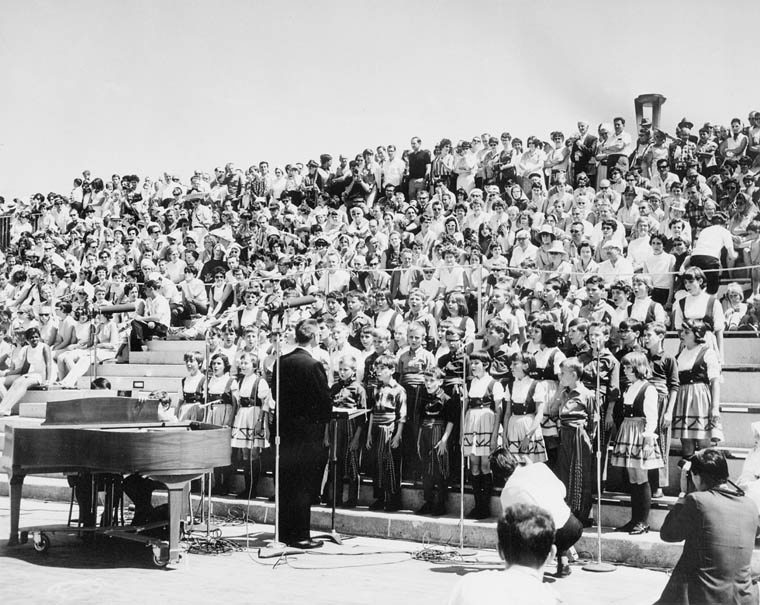
Photo credit ©
Ray Duguay / National Archives of Canada and is part of the Department of Industry
collection.
Above photograph: Various
ethnic groups from many areas on Canada Day and the Centennial of Confederation,
July 1, at Expo 67
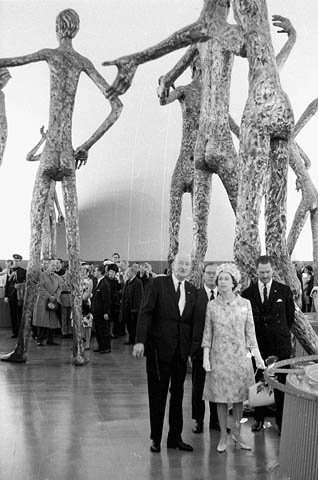
Photo credit ©
National Archives of Canada
Queen Elizabeth II strolls by the aluminum
figures by Mario Armengol that dominated the fifth and last chamber of the British
Pavilion, July 3, 1967.

Photo credit ©
National Archives of Canada
Queen Elizabeth II and Prime Minister Lester B.
Pearson ride the mini-rail, July 3, 1967.
----------------------------------------------------------
As the reader to this Expo 67 in Montréal website
will note, Montréal wasn't the only great place to be to enjoy Canada Day
back in 1967...
Canada Day, 1967 was quite the party
by Sherman Zavitz
Local News - Saturday, June 30, 2007
It was a day to remember! Forty years ago tomorrow, July 1, 1967, Canada
celebrated its 100th birthday.
In countless communities from coast to coast to coast, the historic moment was
observed in a great variety of ways such as parades, parties, barbecues, street
dances and fireworks, along with many events of a purely local flavour.
Although Saturday, July 1 was, of course, the actual birthdate, the entire year
was filled with exciting happenings. Chief among these was Expo '67, a grand and
glorious world exhibition held in Montreal April 28 to October 27. There were
more than 50 million paid admissions to Expo '67, which used as its theme Man
and His World.
Another yearlong event was the Confederation Train, which stopped in 68 cities
as it travelled across the country from January to December. Made up of six
specially designed railway cars, it provided visitors with what was described as
"a moving panorama of Canada from prehistoric times through Confederation to the
present. " Niagara Falls was on the train's itinerary - it spent July 26 to 28
here.
If your memory can stretch back 40 years, you may also recall a song just about
everybody in the country, especially children, was humming or singing in 1967.
Called "Ca-Na-Da," it was written by Bobby Gimby and became the unofficial theme
song of the centennial. In Niagara Falls, a noisy welcome to Canada's 100th
birthday began at midnight June 30, as church bells and the Rainbow Bridge
Carillon bells rang out across the city.
Moments later, a chorus of car horns could be heard on most major streets. As
The Review reported: "Impromptu cavalcades of cars quickly formed, filled with
youths, some waving flags, others just cheering as they cruised the streets down
from Lundy's Lane, along Victoria Ave. and Queen Street for a U-turn around the
block containing City Hall and Centennial Square.
"There was a great hubbub of 'Happy Birthday Canada' and 'Hello Centennial,'
mixed with singing, whistling and shouting.
"Firecrackers popped here and there in the city. Roman candles and skyrockets
were more rare."
At 2 p.m. Canada Day (or Dominion Day as it was then called), four RCAF and four
USAF jet aircraft raced across a clear, sunny sky for a ceremonial fly-past over
the falls.
Then came the monster centennial parade. An estimated 10,000 cheering and waving
residents lined the 4.02-kilometre route from Main Street down Ferry Street and
Victoria Avenue to Queen, ending at Centennial Square.
The Review provided some details about the event: "The huge parade had 1,000
participants, who made up 30 colourful floats, 14 rousing bands, 11 smooth
marching units, four high-stepping majorette groups, fire engines with sirens
screaming, customized and antique cars, a bevy of convertibles and 30 youngsters
with gaily decorated bicycles."
Following the 90-minute parade came the official opening of Centennial Square
beside City Hall. The $150,000 square, which remains one of Niagara Falls'
principal focal points, was the city's main centennial legacy project.
Ribbon-cutting duties were performed by Mayor Franklin J. Miller.
The Ladies Centennial Choir directed by Judith Davison (now MacCarthy) then sang
"The Maple Leaf Forever" and the "Centennial Hymn," composed by Niagara Falls'
own Rev. Kenneth Moyer minister of Lundy's Lane United Church.
That's the way it was as Niagara Falls celebrated Canada's Centennial in 1967.
Now, we are on the eve of the nation's 140th birthday.
Happy Canada Day - See you tomorrow at Optimist Park.
Sherman Zavitz is the official historian for the City of Niagara Falls and is
the Niagara Parks historian. Reach him by e-mail at
sherman.zavitz@sympatico.ca.
Copyright © by Sherman Zavitz and the
Niagara Falls
Review. Used with permission with our sincere thanks.
----------------------------------------------------------
June 23
|
Time Magazine's statistics on Expo
67
Most popular pavilions by
attendance
The Soviet Pavilion:
10,500,000
Czechoslovakia: 7,000,000
Canada's Telephone
Association: 6,000,000
Britain: 5,000,000
"Open pavilions like
Canada's and West Germany's, as well as Habitat also attracted millions
but kept no official count," wrote
Time Magazine. "Only limited capacity held Labyrinth's attendance down
to 1,200,000."
Live performances and
those who watched
"World Festival
troupes played to an audience of 2,136,400. In all, fairgoers watched
1,035 different individual entertainers and groups put on a grand total of
17,823,000 performances."
Figures on some of the
movies shown at Expo
Canadian Pacific Pavilion's
"We Are Young" drew 2,500,000 viewers.
Czechoslovakia Pavilion's
"Kino-automat" drew 67,000 viewers.
Man and His Health
Pavilion's "Meditheatre" drew 20,000 viewers.
|
----------------------------------------------------------
June 22
1967 was a great year
by —
Frank Bucholtz
Forty years ago, Canada was preparing to celebrate its 100th birthday.
To those who don’t remember that time, and that’s a significant portion of the
population, the likely reaction is “So what?”
While Canada Day is celebrated with plenty of enthusiasm in Langley and all
across the country, it’s not a really big deal.
In 1967, it was.
Planning for the centennial year had been going on for years. There were
numerous highlights, with the biggest one being Expo 67 in Montreal, which was a
tremendous success in showcasing Canada to the world. Many people from this
far-off part of Canada travelled to Montreal for Expo, and came back thoroughly
proud to be Canadians.
Interestingly enough, we had a minority government in 1967. The Liberal
government of Lester Pearson was the third successive minority government
elected by Canadians, and few average people had much difficulty with that fact.
In fact, they likely took a look at what the various minority governments had
accomplished and said “we have it pretty good here.”
There were regular and comfortable surpluses. The Canada Pension Plan was
established. A new flag had been chosen. The federal and provincial governments
were putting the final touches on a national medicare system.
There were stirrings of discontent in Quebec, but Pearson had managed those
fairly well by establishing a Royal Commission on Bilingualism and
Biculturalism, and by appointing well-known Quebeckers such a Pierre Trudeau to
his cabinet.
In short, most Canadians were very happy to be living in what they rightly
considered one of the best countries in the world.
There was very little discontent. Even young people, who were beginning to react
strongly to “the establishment,” were pretty content in 1967, despite the fact
that the government was mainly made up of people in their 60s.
Pierre Berton wrote a book about 1967 calling it “The Last Good Year.” While
that may be stretching it a bit, it was a memorable year and a great time to be
a Canadian.
Copyright © Langley Times, British Columbia
----------------------------------------------------------
June 20
THE CZECHOSLOVAKIAN PAVILION IN 1967
The medium was the message
by Robert Fulford
The Czechs are exposition-prone: they enjoy
exhibitions, at home and abroad, and they do them well. At Brussels in 1958 they
won the gold medal for the best pavilion. At Expo they made perhaps the most
ambitious single national contribution to the fair. They brought not only a
pavilion, with its expensive and sumptuous restaurants and its incomparable
films and displays, but also the elegant Koliba restaurant, down at La Ronde, in
which every glass, every ashtray, was stylish; and they brought Laterna Magika,
the film-with-live-actors show. The deputy commissioner-general of their
pavilion explained why: "We are a very small country but we are a proud people.
We think we have done something in this region of Europe where we have
lived these last twelve hundred years. We have created a sort of civilization --
and we want to show it, particularly to the American continent, which has not a
clear idea, an image, of Czechoslovakia." But the image-building was never
obvious: the Czechs made their point with subtlety. In this case, as Marshall
McLuhan puts it, the medium was the message. The medium was the pavilion itself,
and the message was that a country which could produce a walk-through art object
as delightful as this one, must be, in some significant way, admirable. Even
some of those visitors who hate and fear the very idea of Communism found
themselves -- perhaps against their will -- thinking about Czechoslovakia in a
fresh, surprised way. It may eventually be agreed that that was the greatest of
all the Czechs' triumphs.
© Copyright 1968 by Robert Fulford and McClelland
and Stewart Ltd., all rights reserved.
WHAT EVER HAPPENED TO THE "CZECHOSLOVAKIA
PAVILION?" YOU'LL NOW FIND IT LOCATED IN NEWFOUNDLAND!
The Gordon Pinsent Centre for the Arts
History
The Gordon Pinsent Centre for the Arts was opened officially as the Grand Falls
Arts and Culture Centre in 1971. With the amalgamation of Grand Falls and
Windsor, it became the Grand Falls-Windsor Arts and Culture Centre.
As of July 12, 2005, it became the Gordon Pinsent Centre for the Arts, in honour
one of Grand Falls native sons - actor and writer Gordon Pinsent, on his 75th
birthday, and during the town's Centenary.
The story of how this building came to be built is a very interesting one: on
Tuesday, Sept.5, 1967 at Gander International Airport, a Czechoslovakian
Airliner crashed on take off. Of the 69 people on board, 32 died instantly and
five died later in hospital. Without the rescue efforts and dedication of the
people from the James Paton Memorial Hospital in Gander, the Central
Newfoundland Hospital in Grand Falls, and local rescue workers, more lives would
have been lost. In 1968, as a gesture of gratitude, the Czechoslovakian
Government transported to this site the major complex from its pavilion at Expo
'67 in Montreal. It was reconstructed by the Newfoundland government and kept
the exact same design and layout as the original structure. It took several
years to complete the reconstruction due to financial problems, but finally the
Centre was officially opened in July of 1971.
In the Centre there is an art gallery, a four hundred seat theatre, and a public
library.
|
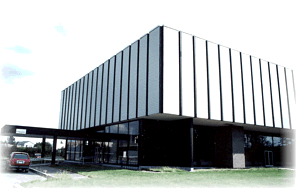
The Czech pavilion is now
known as
the Gordon Pinsent Centre for the Arts
1 Cromer Avenue
Grand Falls-Windsor, NL |
The theatre is named the Neala Griffin Theatre, after the prominent theatre and
performing arts enthusiast who lived in Grand Falls. She was president and
director of the Northcliffe Drama Club and she was also involved with adult
education in the region.
The Art Gallery is named for Gwendolyn Cooper. She was the wife of the mill
manager in the early days of the town and also a prominent arts supporter. Mrs.
Cooper arranged many arts exhibits, and taught artC encouraging many young
artists to pursue their dream. She also started and encouraged the first
performing arts group in this region.
The Harmsworth Public Library, named in honor of the Harmsworth family which
founded the Anglo-Newfoundland Co. Ltd., moved from its original location on
Church Road to this building on November 30, 1971.
This wonderful building continues to attract many cultural events. Performers
and visual artists from all over the world have performed or exhibited in this
Arts Centre. Throughout the year visitors and patrons alike are invited to view
local, provincial, and national artworks and performers as well as use the
public library as a resource centre. Housed in the Art Gallery is a permanent
collection called "Project 2000", sponsored by the Central Newfoundland Visual
Arts Society, which is a fine example of prominent Newfoundland born artists.
The temporary gallery features works by local and regional artists.
The following is an account of the airliner crash, as it appeared in a local
newspaper at the time
THE CZECH CRASH
Thirty two persons died instantly aboard a Czechoslovakian airliner which
crashed at Gander on Tuesday, September 5, 1967. Two more died after being
admitted to the Paton Memorial Hospital, at Gander. The third casualty,
Mr.Pilato, who boarded the flight at Gander, passed away at Montreal General
Hospital. The fourth, a man of Polish nationality, died at Halifax and another
expired in Montreal General Hospital the following weekend.
The Russian built IL 18 Turbo prop aircraft crashed seconds after taking off
from Gander. The aircraft, in command of Captain Bacovsky, may have been
attempting to land on the soft marsh when it hit the railway tracks and
telegraph poles and somersaulted.
The first survivors to be located were: a stewardess, flight engineer, radio
operator, a man, his wife and four children. Seven hours after the crash, the
last survivor, a woman with her legs badly injured, was located under a piece of
wreckage. Sixteen of the bodies have not been identified except by nationality
and sex.
The remainder of the bodies were released by Magistrate Jack A. White of Gander
and company planes belonging to Czechoslovakian Airlines and Cubana Airlines
have since transported the bodies to Cuba and Prague.
Authorities at the Victoria General Hospital, Halifax and the Montreal General
have commended the Paton Memorial Hospital for the manner in which the survivors
of the crash were prepared for transfer to their respective facilities. Of the
original 37 survivors admitted to the hospital here, 20 were transferred to
Halifax and 7 to Montreal. Two died at Paton Memorial and one of the seven
transferred to Montreal, Mr. Pilato, has also died, bringing the death toll to
37 out of 69 persons on board the aircraft. The hospital in Gander was assisted
during the emergency, by: The Central Newfoundland Hospital, Grand Falls;
General Hospital, St. John's; St. Clare's, St. John's; Provincial Department of
Health Nursing Service, St. John's; Victoria General Hospital, Halifax; Montreal
General Hospital, Montreal; Red Cross Service, St. John's and Toronto; and the
United States Naval Hospital, Argentia.
Hospital Administrator Mr. Gover said, "The assistance received during the
emergency was terrific." He made special mention of Les Gettel, Manager of
Allied Aviation, for arranging transportation; members of the armed forces, both
Canadian and American; members of the Royal Canadian Mounted Police; Eastern
Provincial Airways; blood donors; Department of Transport; and numerous others
who came forward and offered their services. Though the hospital maintains a ten
bed crash ward, it was not in use during the tragedy because there was ample
room to accommodate the crash victims throughout the facility.
The bodies of 29 victims left Gander on September 10th for the return trip to
Prague. On hand for the simple ceremonies were: Rev. W. Vardy of the United
Church; Rev. J.H. Moss of St. Martin's; Rev. J.P. McCarthy; the Hon. Charles R.
Granger, representing the provincial government; Mr. James Tucker, M.P.;
Magistrate Jack A. White of Gander; The Consul General of the Czechoslovakian
Embassy in Montreal; Edward Bilek, president of the Czech airline; L. Kilack and
airport manager, Jack James.
Mr. Bilek said it was his feeling that the number of people who died would have
been greatly increased had it not been for the prompt action of the staff at
James Paton Memorial Hospital. He said people of Czechoslovakia would always be
in debt to those who did so much. He said, "the interest and concern shown by
the people of Gander, who came out for the ceremony, is also appreciated." Close
to 1,000 people attended the ceremony. Final identification for all but two of
the victims came from Prague late that afternoon.
The Ilyushin IL 18D turbo prop airliner exploded into flames about 4000 feet
beyond the end of Gander airport's runway. The aircraft, a Soviet built four
propeller turbo prop aircraft, was owned and operated by CSA (Czechoslovakia
State Airlines), and was only in service about three months and was practically
new to CSA's fleet. It was given its certificate of airworthiness and
registration on May 16, 1967. This aircraft was the mainstay of Soviet transport
airliners in the early 1960's and was being built and exported to communist bloc
countries. Hundreds were in service all over the world. The IL 18 was a modern
passenger transport of sleek design and comparable to western standards of
technology and was well proven in service with many airlines.
The aircraft, an IL 18D registered OK WAI left Prague, Czechoslovakia for its
final destination Havana, Cuba with two technical and refuelling stops at
Shannon, Ireland and Gander, Newfoundland. The aircraft stopped at Shannon and
continued its flight across the north Atlantic uneventfully to Gander. The crew
which flew the plane to Gander deplaned and was replaced with a new crew
stationed at Gander. The aircraft lifted off near the end of the runway
appearing normal except for a shallow climb out. The air plane, with 8900ft. of
runway behind it, pancaked into very boggy ground beyond the end of the runway.
The right wing tip struck a radar mast and exploded. Many of the passengers
thought it occurred in flight. However the explosion occurred when the left wing
and propellers struck the Canadian National Railroad tracks.
© Copyright by Grand Falls-Windsor Arts and
Culture Centre, all rights reserved.
Click here
for photo gallery of the Grand Falls-Windsor Arts and Culture Centre which
includes: Balcony seating; seating and stage; Harmsworth Library; Main Lobby:
Theatre Doors; Main Lobby and Staircase; and a few theatric scenes.
----------------------------------------------------------
June 17
The Canadian Legion magazine has published in their
May edition: "Expo 67: Bringing The World to Us." This article written by
D'Arcy Jenish is filled with facts and quotes on the subject of Expo...
Expo 67: Bringing The World To Us
by D'Arcy Jenish
Deirdre McIlwraith was 24, a graduate of Queen's
University in Kingston, Ont., and fluent in French and Spanish when she landed a
job as a protocol officer with the Canadian Corporation for the 1967 World
Exhibition, the organization that planned, built and ran Expo 67 in Montreal.
McIlwraith worked at the Restaurant Hélène de Champlain, the venue used to host
lunches for visiting dignitaries and heads of state. She officiated at events
for Princess Grace of Monaco and Princess Margaret, the sister of Queen
Elizabeth II. She remembers the representatives of the Ivory Coast in equatorial
Africa, who were uniformly tall, spoke impeccable Parisian French and were
elegantly dressed in the latest fashions from France. She vividly recalls a
tiny, frail and elderly Haile Selassie, Emperor of Ethiopia, who arrived with
his dog and insisted that it sit under the table next to him and be served
ground filet mignon. She recounts a tense lunch in late July when Montreal Mayor
Jean Drapeau rebuked French President Charles de Gaulle after his infamous "Vive
le Québec libre" speech delivered from a balcony at city hall.
McIlwraith was on duty for dozens of such lunches, but what she remembers most
vividly was the exuberance and almost breathless excitement of the ordinary
people who flocked to Expo 67 from every corner of Canada and around the world
from the moment the gates opened to the public on Friday, April 28, 1967. "Right
away, the fair was a hit," she says. "It was fantastic. It was wonderful to feel
that Canada was meeting its potential. You really felt anything was
possible--that we could have a bicultural, bilingual Canada, that we could have
the best of Europe and the best of North America."
Expo 67 was a celebration of Canada's first 100 years and it occurred at a time
when Canadians were in a celebratory mood. After the Great Depression and World
War II, the 1950s and 1960s brought unprecedented prosperity and optimism. It
was a time of striking medical advances, big families, increasing urbanization
and the creation of generous social programs. Immigration was also enriching
Canadian society. Newcomers from southern and eastern Europe, from Asia, Africa
and the Caribbean, were making the country more diverse, more tolerant and more
exciting. There were very disturbing developments internationally such as the
Cold War and the conflict in Vietnam, but they were considered by many to be
largely other people's problems and nothing to put a damper on Canada's
centennial or its world fair.
The fair opened "officially" on April 27 while hundreds of workmen scrambled to
put finishing touches on pavilions, restaurants and other facilities. Governor
General Roland Michener, Prime Minister Lester B. Pearson, Mayor Drapeau, all 10
provincial premiers and 53 heads of state toured the fair and then some 7,000
invited guests got their first peek. Expo was built at a cost of $415 million on
two islands in the St. Lawrence: Île Ste-Hélène, a natural formation that was
enlarged by millions of tonnes of fill; and the totally man-made Île Notre-Dame.
The site spanned nearly 1,000 acres, which was room enough for 39 restaurants,
62 snack bars, an amusement park called La Ronde, parking for thousands of
vehicles and the pavilions of 62 participating countries as well as hundreds of
corporations.
Many of the official guests were star struck by what they saw, especially the
space-age geodesic dome that housed the American pavilion, the 10-storey,
futuristic housing development called Habitat '67 that consisted of randomly
stacked dwelling units, and an internal transportation system of hovercrafts,
Venetian-style gondolas and two elevated railways. Quebec Premier Daniel Johnson
described Expo as "more wonderful, more beautiful that anyone had ever
predicted," and the prime minister told a journalist: "Anyone who says we aren't
a spectacular people only has to see this."
After the politicians, the dignitaries and the VIPs left, ordinary Montrealers
and others from further away began lining up for the public opening at 9:30 the
following morning. The first person through the gates was Al Carter, a
39-year-old jazz drummer from Chicago who had paid $12 for a seven-day Expo
passport bearing the number 00001. By the end of that day, some 335,000 people
had visited the fair, twice as many people as expected. On Sunday, April 30,
attendance hit an astonishing 530,000, which would prove to be Expo's biggest
one-day crowd and which pushed the total for the first three days over the one
million mark.
Then the reviews began to appear and they were almost universally laudatory.
Time magazine devoted seven pages to Expo in its May 5 issue and was giddy in
its descriptions. The crowds, Time reported, were "stirred, made happy, thrilled
and dazzled by a world spectacularly bigger than themselves." The magazine went
on to describe Expo as "a Centennial adventure in which a Canada newly brimming
with self-confidence is playing host to the world and perhaps finding itself
into the bargain."
Not to be outdone, the New York Times newspaper declared that: "The
sophisticated standard of excellence...almost defies description." The Economist
magazine stated that: "The acclaim won for the man-made islands in the St.
Lawrence may have done more for Canadians' self-confidence than any other recent
event." Among domestic commentators, few could surpass Peter C. Newman's
observation that: "This is the greatest thing we have ever done as a nation
(including the building of the CPR)...if this sub-Arctic, self-obsessed country
of 20 million people can put on this kind of show, then it can do almost
anything."
By the time the fair closed its gates for good on Sunday, Oct. 27, Expo 67 had
achieved renown as one of the most successful world exhibitions since the first
of its kind was held in London, England, in 1851. The only serious rivals were
the Paris world fair of 1900, which enjoyed the participation of 58 countries
and drew 50.8 million visitors, and the 1958 Brussels exhibition, which drew
some 41.4 million people. Expo 67 attracted 50,306,648, more than 2½ times the
entire population of Canada at the time.
For Montrealers, the end of the fair was an emotional event. "The mood that
prevailed during Expo's 185th and last day was a curious bittersweet mixture of
joy and pride and sadness," wrote the Montreal Gazette newspaper's Nick Auf der
Maur. Staff at various pavilions handed out horns and flags bearing the Expo
logo and the words "Au Revoir Expo," but as Auf der Maur noted: "These failed to
achieve a holiday atmosphere. Despite the large crowds everywhere, the day was
more of a fond, personal farewell in a summer of romance."
That Expo 67 had made such an impact was all the more remarkable given its
origins.
In the late 1950s, Conservative Senator Mark Drouin began pushing the idea of
hosting a world's fair to celebrate Canada's centennial. But in 1960 the
Paris-based Bureau of International Exhibitions (BIE) awarded the 1967 universal
exposition to Moscow since that year the Soviet Union would be celebrating the
50th anniversary of the Russian Revolution. The Soviets worked on the project
for two years and then scrapped it as too costly.
Mayor Drapeau and a small group of talented, ambitious Montrealers saw their
opportunity. They would convince the BIE to award the fair to their city, and
they did. The bureau made its decision on Nov. 13, 1962. That left Montreal with
just 4½ years to get ready for an event that would normally take seven.
The biggest miracle about Expo 67 may be that it was finished and opened on
time, and those who built it have treasured the memory ever since. "My wife
thought I was crazy to accept a position," recalls director of operations
Philippe de Gaspé Beaubien, who went on to found the Quebec-based broadcasting
company Télémedia Inc. "We had to work night and day. I lived in a room on top
of the Hélène de Champlain and my children used to come and see me there on the
weekends. Fortunately, I have a very strong and supportive wife."
"The part that was really exciting for me was to see the emergence of the
pavilions," says Montreal stockbroker Daniele Touchette, who was a hostess and
led visiting foreign delegations on tours of the construction site. "At first,
there was nothing there. You'd see scale models and then you'd see one pavilion
coming up and then two and three. It was so exciting."
Diana Nicholson was a 22-year-old, bilingual American when she became one of the
first 100 employees of the Expo corporation. She was hired as a liaison person
in the public relations department and was supposed to handle communications
with French West Africa and Latin America. That quickly changed. "I spent about
a year travelling across Canada to every kind of exhibition or show conducting
public briefings on the project," she says. "I remember travelling with this
enormous scale model, which turned out to be totally inaccurate because we
didn't really have any idea of what we were going to be putting in various
places."
One of the first challenges was to develop a theme for the fair, a task assigned
to a select group of intellectuals, artists, scientists and administrators,
including the novelists Hugh MacLennan and Gabrielle Roy. They met for three
days in May 1963 at Montebello, Que., and came up with Man and His World, which
was inspired by the Antoine de Saint-Exupéry story Terre des Hommes and the line
"To be a man is to feel that by carrying one stone you contribute to the
building of the world."
The Expo corporation and the City of Montreal spent about nine months trying to
settle on a site. Developers, landowners and speculators lobbied for a dozen or
more properties in and around Montreal, but the mayor had his own unique plan.
The fair would be built on two islands in the St. Lawrence River, one
substantially enlarged, the other built from scratch with 25 million tons of
fill from the new 34-kilometre long subway system.
Many thought the idea ridiculous, including the prime minister. In a letter to
Drapeau, Pearson dismissed the plan as "one of the silliest things I have ever
heard," and added: "With four million square miles of land we should be able to
find a plot some place." But there was no swaying the mayor. On Aug. 12, 1963,
Pearson himself pulled a lever and a front-end loader dumped the first 25 yards
of earth onto Île Ste-Hélène. For the next seven months, a truckload of fill was
deposited every four minutes, around the clock and by June 26, 1964, the city
turned over the islands to the Expo organization.
The man who built the fair was Colonel Edward Churchill, a retired army officer
recruited from a cushy government job in Ottawa. He had 878 days to get the job
done and it nearly killed him. After months of long days that frequently ended
at midnight, he collapsed from exhaustion during a conference and required a
stay in hospital. Churchill adopted the United States space program's critical
path technique for co-ordinating and advancing multiple tasks simultaneously.
Every single project on the islands was broken into stages from planning right
through to completion to ensure that there were schedules and that people stuck
to them.
Another big challenge was to convince the world to participate, and that task
fell to Expo's commissioner Pierre Dupuy, a career diplomat recruited from the
Department of External Affairs. He visited 125 countries, met 90 heads of state,
travelled more than 250,000 miles, enlisted every Canadian diplomat abroad to
work on the nationals in their countries and succeeded wildly.
Nicknamed Mr. Energy by his staff, Dupuy convinced 62 nations to participate, a
new record for a world fair, and they came from every corner of the world,
including Great Britain, France, Germany, Venezuela, Jamaica, Barbados,
Cameroon, Ghana and Tanzania, Korea, Burma (now Myanmar), Iran and Kuwait.
Of all the pavilions and exhibits, two became landmarks that captured the
futuristic spirit of the entire enterprise. The first was America's geodesic
dome, which was designed by the architect, inventor and visionary Buckminster
Fuller and known as Bucky's Bubble. While some fairgoers found the exhibits
pedestrian, the structure itself was striking--a sphere 250 feet in diameter and
200-feet high with a cathedral-like grandeur inside. The exterior was made of
acrylic panels attached to a honeycomb-like frame of steel tubes, and it was
transparent. That gave the dome "a light, fairy-tale feel," according to author
Pierre Berton, who added: "At night, lit from within, the dome was sheer
fantasy."
The other structure that became an enduring symbol of the fair was Moshe
Safdie's Habitat '67. Safdie was a 28-year-old architect who was born in Israel,
but grew up in Montreal and developed the concept in his master's thesis at
McGill University. It consisted of 354 pre-fabricated, concrete boxes, which
were hoisted into place with cranes and placed helter-skelter to form 158
apartments. "Just about every rule, precedent, practice, custom and convention
is broken by Habitat," Ada Louise Huxtable of the New York Times wrote. But she
went on to describe it as "a significant and stunning exercise in experimental
housing."
Habitat '67 remains in use to this day as a housing development, though most of
the units are privately owned. In 1976, a fire destroyed the acrylic exterior of
Fuller's dome, but it was replaced and the structure now houses a museum called
the Biosphere. The amusement park continues to operate as La Ronde, but there
are few other physical reminders of Expo 67.
The passage of time has also erased much of the goodwill and idealism that made
Expo possible. The kidnapping crisis of October 1970, the election of separatist
governments in Quebec, the exodus of English Montrealers and the economic
decline of Montreal all served to erode the optimism and camaraderie that
allowed Canadians to dazzle the world. "It was a very interesting time," says
Beaubien, now in his 80th year. "Our minds expanded." And so did our sense of
what it meant to be Canadian and what we could achieve when we worked together.
Copyright © by D'Arcy Jenish and the
Canadian Legion Magazine, May, 2007
edition. Used with permission with our sincere thanks!
----------------------------------------------------------
June 16
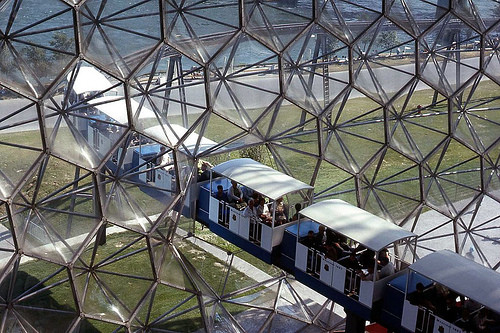
Photo credit: © the Jason Yoder collection at Flickr.com
Take the blue mini-train to enchantment
Written by Maclean's magazine, June 1967 edition
THE FIRST thing sensible Expo visitors should do is
catch the blue mini-train. At 50 cents, the hour-long trip is the best ride at
the fair. Not only is it half as cheap and twice as exciting as Sean Kenny's
overpublicized Gyrotron, it's also the only way visitors can soar above the
crowds, orient themselves and admire the incredible architecture from all
angles.
Actually, there are three mini-rails. But the
other two, carrying yellow trains and costing only 25 cents, are minor
mini-rails and less spectacular. One merely trundles past the few pavilions the
blue train misses; the other plows a fairly obvious path around the rooftops of
the La Ronde amusement area.
The mini-trains operate on the monorail
principle, are fully automatic and pay scant attention to the conventional
railway problems of gradients and curves. One moment the train is rolling along
the water's edge; the next it is looping high over the river and curving back at
the fourth-floor level of the French Pavilion.
The blue or major mini-train covers most of the
worthwhile sights from one vantage point or another. It plunges right through
the heart of the giant U.S. geodesic dome, circumnavigates the Soviet Pavilion,
ducks under the plastic of the Ontario Pavilion and connects with both the
Expo-Express train service and the Montreal Métro subway station at Expo. In
between, little is missed and camera buffs will find themselves clicking
shutters every time they turn around.
The mini-rails have a couple of mini-disadvantages.
One is that a breakdown of a single train brings the whole closed system
grinding to a halt. It can be a chilly business getting stuck in the open-air
cars -- especially at night. It can also be tedious. One Expo guide tells of the
nightmare experience of being stalled with a foreign VIP for 90 minutes in front
of a pavilion he didn't know much about.
The other drawback is that the mini-trains are more
sight-seeing excursions than transportation systems. To get to point A from
point B it's usually quicker to walk. The 3½ -mile Expo-Express train, which is
fast and free, links the four main Expo sites. But once away from this main line
the visitor has to depend mainly on his feet.
There are of course a bewildering variety of other
modes of transportation. Steamboats, gondolas, canoes and even Hovercraft cruise
the many lakes and canals. Conventional tractor trailer trains service some
areas. And the really affluent visitor can hire a boy-powered Pedicar for 10
cents a minute -- a modernized version of the rickshaw. But none of these trips
give half as much value for the money as the blue mini-rail.
© by Maclean's magazine, 1967 June edition. All
rights reserved.
----------------------------------------------------------
EXPO 67 weekend at La Ronde June 16-17
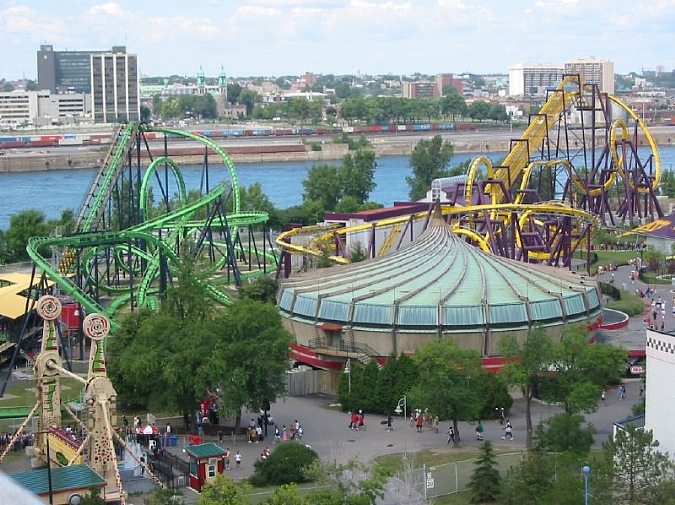
Photo credit: © the Funkafonik collection at Flickr.com, taken in 2004 using a Canon PowerShot
A40.
MONTREAL, June 14 /CNW Telbec/ - This weekend, June
16 and 17, La Ronde will be celebrating EXPO 67's 40th anniversary, with a host
of activities taking place during this special retro event.
Visitors who present their original EXPO 67 passport
will be admitted free to the La Ronde grounds. As people enter the park, they
will be welcomed by delightful EXPO hostesses and charmed by go-go dancers
performing on podiums along the main walkway. Saturday's attractions will
include "go-go stilt walkers", an exhibition of cars dating from 1967 and 67
cents hot dogs.
At Le Jardin des Etoiles at 7 p.m., audience members
will experience 40 years of emotions during Jean-Guy Moreau's "40 ans, 40 voix"
show. In addition, guided tours on Saturday at noon, 2 p.m., 4 p.m. and 8 p.m.
and Sunday at noon, 3 p.m. and 6 p.m. will enable visitors to rediscover the
site.
Celebrating part of Montréal's heritage
Starting at noon on Saturday there will be speeches and the inauguration of Le
Galopant, the entirely restored Antique Carousel. Guest dignitaries representing
heritage-preservation organizations will include:
Benoit Labonté, mayor of the Ville Marie borough and executive committee member
responsible for Le Patrimoine (heritage issues)
Louise Letoucha, chair, Conseil du Patrimoine de Montréal (heritage council)
Céline Topp, director of the City of Montreal's Bureau du Patrimoine (heritage
office)
Dinu Bumbaru, Héritage Montréal policy director
Daniel Turp, National Assembly member for Mercier
riding
Invitation to media members: Saturday, June 16 at noon
Media members wishing to attend the speeches and the inauguration of Le Galopant
are asked to confirm their presence by telephoning (514) 397-2001, ext. 2703 or
sending an e-mail to ngoyer@laronde.com
About Six Flags: The world's largest regional amusement park firm and owner of
La Ronde, Six Flags Inc. is a publicly traded company (NYSE: SIX) based in New
York.
----------------------------------------------------------
June 13
On this date, the Ottawa Citizen publishes the
following article:
"The Greatest Show on Earth" written by Gord Atkinson who passionately
writes about his fond memories of Canada's Centennial and Expo 67.
And in yesterday's edition of the Ottawa Citizen, they
published
"Happy Centennial plus 40" written by Eric Watson who has been one
of the many contributors
to this Expo 67 website.
----------------------------------------------------------
June 9
The Toronto Star lists the "7 wonders of
Canada"
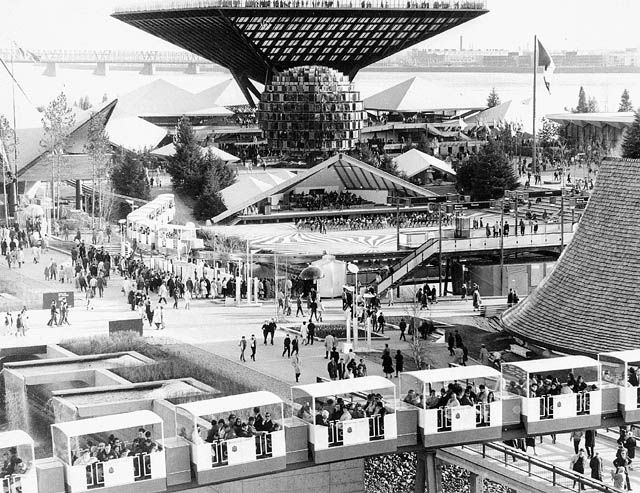
Photo credit ©
the National Archives of Canada
"It's not the land that has made our country what it
is...it's the way we've shaped it and the things we've built on it, the
monumental achievements of engineering and imagination in which we took a
wilderness and forged it into a nation." -- Christopher Hume, Architecture
Critic, Toronto Star.
SEVEN GREAT STRUCTURES THAT MADE A NATION:
1. The Confederation Bridge linking P.E.I. to the
mainland
2. The transcontinental railway
3. The Quebec Citadelle
4. Expo 67 in Montreal
5. The Rideau Canal
6. The CN Tower
7. The St. Lawrence Seaway
A descriptive detail on why these structures were
chosen are included in the report by Christopher Hume, plus 7 other alternative choices
deemed to be of historical importance to Canada.
To read Hume's excellent report filed on this date from the Toronto Star,
please click: "7 wonders
of Canada"
----------------------------------------------------------
June 3
The Ottawa Citizen
newspaper wants to hear from
you about your
"Centennial Memories"
What did you do in 1967? Take a special trip?
Volunteer on a Centennial project? Visit Expo in Montreal? Click
here to share your unique
memories and photos. Read other submissions
here and see the Citizen on July 1
to read the best.
Letters must include the writer's full name, address and daytime phone number.
Recent articles by the Ottawa Citizen:
Audio Slideshow: "1967" -- see the year in pictures while listening to the
"CA-NA-DA" theme song by Bobby Gimby (small slides)
Audio Slideshow: "1967" -- see the year in pictures while listening to the
"CA-NA-DA" theme song by Bobby Gimby (large slides)
Canada's mayors remember Centennial year
Pilgrim of patriotism by Kurt Johnson
Main index to the above links, click
here.
----------------------------------------------------------
Now available at newsstands as of May 31, 2007, an excellent
write-up on Expo 67 by Christopher Moore appears in The Beaver, Canada's
History Magazine. Their cover for this edition, is a parody of the innovative
artwork found on The Beatles iconic "Sgt. Pepper's Lonely Hearts Club Band" LP
which was released, June 1, 1967 in the U.K. The significance is that this new album
by the Beatles was heard for the very first time in North America at Expo 67.
Gilles Gougeon, in a separate story not found in The Beaver magazine, tells how it happened to Bernard St-Laurent,
host of CBC's "C'est la vie."
To hear the interview, click
on the link and scroll down until you see "C'est
la vie, April 29, 2007" and then click: Gilles Gougeon.
http://www.cbc.ca/cestlavie/audio.html

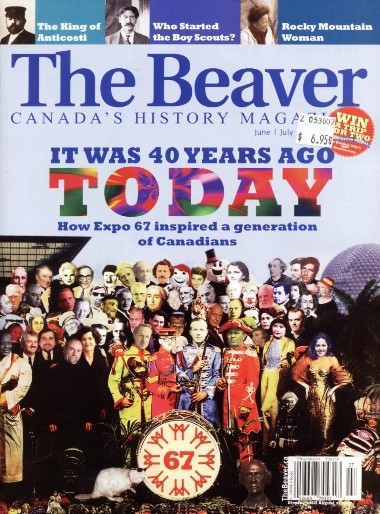
|
Did you know...
74.5 percent of visitors to this "Expo 67 in
Montréal" website are
Canadians
Our three busiest days for visitors were:
April 22, 2007: 936 visitors
April 27, 2007: 1,941 visitors
April 28, 2007: 1,054 visitors
|
|
